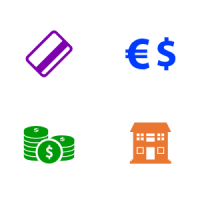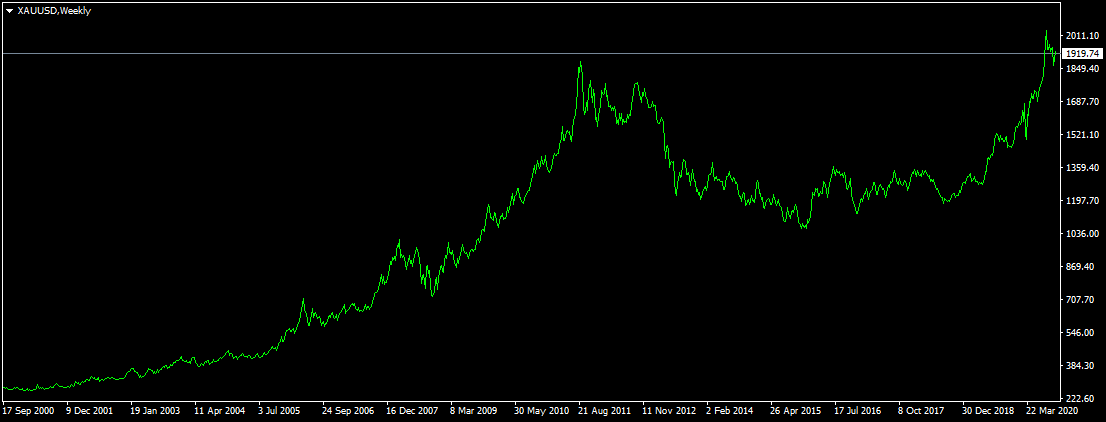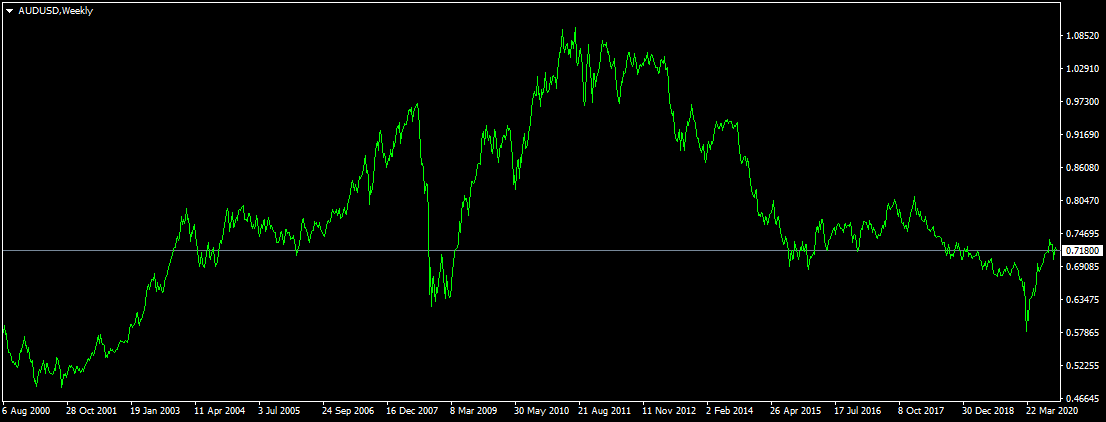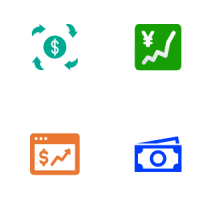Table of content
Any trader who has some experience in the Forex market is very likely to come across so-called commodity currencies. Those types of currencies are usually highly influenced by the price movements of particular commodities.
For example, the Australian dollar is usually tied to gold and silver prices. The main reason for this is the fact that Australia is one of the largest producers and exporters of precious metals in the world.
In fact, this relationship persisted for several decades. Because of this reason, some market participants even started trading AUD as a proxy for investing in gold and silver, earning some interest along the way. So the basic principle here is this: if the prices of precious metals rise, then it is likely to lead to an appreciation of the Australian dollar against other currencies. On the other hand, the declining gold and silver prices are likely to have a negative effect on the exchange rates of AUD.
However, it is important to keep in mind that this does not mean that the Australian dollar will always move in the same direction as gold and silver prices. The fact of the matter is that because of interest rate changes, economic growth rates, and other factors, the Australian dollar can actually diverge from precious metals from some period of time. This became especially apparent in 2008, as well as in 2019.
Consequently, it is always helpful to take a look at the prices of precious metals when making decisions about trading the Australian dollar. However, making all of the conclusions solely based on gold or silver prices can be very misleading and can potentially lead to some serious mistakes during trading.
Instead, it is helpful to take a look at the latest interest rate changes by the Reserve Bank of Australia. It is also useful to check the latest statements by the Chairmen and board members of RBA in order to get some idea about the possible future path of the monetary policy in Australia.
In addition to that, it can be handy to check out the latest GDP and inflation rates in the country, as well as other more detailed indicators, such as retail sales, home sales, and other important pieces of information. Now let us go through each of those factors mentioned above, in greater detail.
Why Is Australian Dollar Tied to Gold and Silver Prices?
When discussing the relationship between AUD and precious metal, the first question which comes to mind is: why is there such a degree of the positive correlation between those securities?
Well, the fact of the matter is that as mentioned before, Australia is one of the largest producers of gold and silver in the world. When the prices of precious metals rise, it does have several implications for the Australian economy.

Firstly, it is important to keep in mind that rising prices of gold and silver are highly likely to lead to a considerable increase in revenue for many mining companies in Australia. Now, if for example, some Australian mining company increases its revenue by $100 million, it does not necessarily mean that its profits will also expand by the same amount.
Here it is worth noting that those firms have to spend millions of dollars on salaries of employees, for equipment, research, utilities, rents, and other expenses. However, unless the company is run by very inefficient management, or faces some unaccounted for financial headwind, then it is highly likely that this will increase the firm’s profits by tens of millions of dollars.
Generally speaking, this can have a positive impact on the Australian economy, since those mining companies now have more financial resources to increase their capital expenditure and also hire more people. At the same time, shareholders of those firms also have a chance to benefit from increased dividend payments.
It is also important to keep in mind that in this case, the Australian government will also benefit from increased tax revenues, coming from the mining companies. So as we can see here, the rise in the prices of precious metals can definitely have a positive effect on the Australian economy in several ways.
Obviously, the opposite is also true. If the gold and silver prices drop, then the Australian mining companies are likely to be forced to cut costs. This can come in the form of laying off some employees, which can result in a rising unemployment rate in the country. In addition to that, those firms might also reduce their capital expenditure and even cut dividends for shareholders. Finally, the tax revenues of the Australian government is also likely to be considerably reduced, as the local mining companies lose some of their profitability.
Now, since the market is well aware of those realities, it does tend to respond to any significant changes in the gold and silver prices, having a notable impact on the AUD-based currency pairs.
Australian Dollar as a Proxy for Investing in Gold and Silver
One interesting dynamic which developed over the years is the fact that some market participants might be using the Australian dollar as a proxy for investing in gold and silver. This might be surprising for some people. After all, the obvious question here is: why will not all those market participants buy gold and silver directly, instead of using the AUD as a proxy?
Well, actually, using the Australian dollar as a proxy for investing in precious metals does have some important benefits. Firstly, it is important to point out that one of the most important downsides of buying gold and silver is that they do not pay investors any interest, dividend, or rent. So purchasing physical precious metals is not that attractive proposition for many income investors.
At the same time, there are many market participants who want to earn some income, but also desire to have some sort of exposure to gold and silver prices. Therefore, one of the ways to achieve this is by investing in savings accounts, certificates of deposit, and government bonds, which are denominated in the Australian dollar.
The reason behind this is that in this case, investors will be able to receive a steady income from those investments. In addition to that, in the case of rising gold and silver prices, they are likely to benefit from the appreciation of the Australian dollar against other currencies.
Obviously, this type of investing is not strictly limited to fixed income instruments. The market participants can also invest in the Australian property market and receive a rental income as a result. Or, alternatively, they can purchase the Australian dividend-paying stocks as well.
Here it is also worth mentioning that storing physical gold and silver does have some costs. So effectively, this asset has a small negative yield as well. In addition to that if one wants to get some liquidity, investors can not just sell 0.1 grams of gold. On the other hand, the market participants can withdraw any amount of Australian dollars they wish.
So as we can see from those arguments, for some investors, investing in the Australian dollar is much more convenient and simple, compared to buying physical gold and silver.
Cases of Divergence
When talking about the relationship between the Australian dollar and precious metals, it is important to point out that despite all those arguments mentioned above, it does not represent the case of a 100% positive correlation. The reality of the matter is that there have been cases of significant divergence between those securities. To illustrate this better, firstly, let us take a look at this weekly gold price chart:

Let us now compare this to the weekly AUD/USD chart below:

As we can see from the above diagrams, back in 2000 both the gold price and the exchange rate of the Australian dollar were at historic lows. The gold price was mostly moving within the $250 to $300 range. At the same time, the Australian dollar kept losing ground against the US dollar, by 2001 AUD/USD fell all the way down to near $0.48 mark, a level not seen in several years.
This is not very surprising since, during the 1990s, the US Federal Reserve has authorized a number of rate hikes. In fact, by 2000, the federal funds rate has reached 6.5%. So, obviously, at that time, investing in USD denominated assets was very attractive for investors and offered a more profitable alternative to gold, which pays no interest.
However, the situation has changed since 2001. From the beginning of the year, the US policymakers have cut rates repeatedly, until reducing them all the way down to 1%. It goes without saying that this made the US dollar less attractive for the market participants. It is not surprising then that during the subsequent period, the US dollar suffered a steady depreciation against other major currencies.
On the other hand, faced with such low interest rates, gold once more became an attractive store of value for some investors and since 2002 its price has risen steadily, until eventually evening going above the $1,000 mark in 2008.
From 2002 to 2008, the Australian dollar has benefited considerably from the rise in the gold price, with AUD/USD rising from $0.77 to all the way up to above $0.96 level. So we can see here that during this period the correlation between the Australian dollar and precious metals was quite strong.
However, from August 2008 we have the first case of divergence. It goes without saying that the 2008 Financial Crisis led to economic uncertainty. This is usually very beneficial for gold prices, which has risen considerably from 2008 until 2011. Yet, in sharp contrast to this development, the Australian dollar has faced some massive losses, dropping all the way down to $0.68 level.
One of the reasons behind this move was the fact that in response to the financial crisis, the Reserve Bank of Australia has reduced its key interest rates from 7.25% to 3%. As a result, the Australian dollar became less attractive for traders and investors, leading to its depreciation.
However, this panic selling has not persisted for long. From Spring 2009, the Australian dollar began to recover, eventually reaching a peak of $1.10 against the US dollar, benefiting from rising gold prices.
This was followed by an extended period of decline in gold prices. As a result, the Australian dollar also suffered some steady losses, with AUD/USD trading close to $0.70 level by 2019.
This is exactly the point where we have the second case of divergence. During 2019, gold started making significant gains, advancing steadily through the year. This upward trend was strengthened even further with the outbreak of the COVID-19 pandemic. In fact, during 2020, the gold price was even able to surpass 2011 all-time high levels.
Therefore, logically speaking this latest trend should have benefited the Australian dollar tremendously. However, the realities on the ground were quite different. In fact, the AUD simply kept depreciating and by March 2020, fell all the way down to 0.58 level. So what was the reason behind those unexpected moves?
Well, the fact of the matter was that the Reserve Bank of Australia was already cutting rates in 2019. In fact, the economic downturn, caused by the outbreak of the pandemic, led to RBA cutting rates down to 0.25%. For years, the Australian dollar has been one of the favorite currencies to carry traders. In fact, back in 2007, the AUD was one of the highest yielding currencies in the developed world, with the RBA cash rate at 7.25%.
However, as Australian policymakers dropped the rates all the way down to 0.25%, this made the AUD much less attractive for traders and investors. It is not surprising then that this loss of appeal led to a significant depreciation of the Australian dollar.
At the same time, we can also notice from the chart that, one month after the last rate cut, the Australian currency began to recover. In fact, the AUD/USD pair has risen all the way up to $0.72 level. Therefore, it is safe to conclude that since April 2020 the high degree of a positive correlation between the Australian dollar and the gold and silver prices have been restored.
Consequently, from observing the long term AUD/USD chart, we can conclude that most of the time there is a strong positive correlation between the value of the Australian dollar and gold and silver prices. However, there are cases of divergence, especially in times of major policy changes by the Reserve Bank of Australia. Consequently, it is important not to make all trading decisions with the AUD trades solely based on commodity prices. It is much wiser to take into account other economic indicators into account.
Other Important Indicators for Australian Dollar
As we have seen from the previous example, the cash rate, set by the Reserve Bank of Australia has a significant impact on the value of the Australian dollar. Everything else being equal, the rate hikes tend to benefit the AUD, while rate cuts are likely to lead to the depreciation of the Australian dollar.
However, for the sake of accuracy, it is important to mention that there are indeed other indicators involved which can also have a notable impact on the exchange rates of the Australian dollar. Here it is worth remembering that the Reserve Bank of Australia has a single mandate of price stability. The Australian policymakers define price stability as maintaining the annual consumer price index, also known as CPI within a 2% to 3% range.

This means that the latest CPI releases can have a major impact on AUD-based currency pairs. For example, if the latest CPI data shows the inflation rate slipping below 2%, then this might be a sign that at some point into the future the Australian policymakers might decide to cut rates in a bid to stimulate inflation and the economy. Consequently, everything else being equal, when the latest announcement shows CPI below 2% it can have a negative impact on the value of the Australian dollar.
On the other hand, if CPI is above 3%, then it means that in the future the Reserve Bank of Australia might decide to increase the interest rate in order to contain inflation. This in turn, generally tends to strengthen the Australian dollar against other currencies.
It is also helpful to keep in mind that, when it comes to CPI, it is not only the headline number that matters but the latest inflationary dynamics as well. For example, if CPI is at 1.9% and remains flat for some months, then it is less likely for RBA to respond with policy changes. On the other hand, if CPI is at 1.9% when during the previous month it was 3%, then this suggests that there is a sharp fall in Australian inflation rates. Consequently, in this scenario, it is much more likely that the Australian policymakers will respond by rate cuts or other easing measures.
Another major indicator for the Australian economy is the gross domestic product announcements, also known as GDP reports. This measures the total value of goods and services produced in an economy within a year. In the case of developed economies, if the real GDP growth rate is 2% or higher it is generally considered to be a good sign for the economy Obviously, in the case of developing countries the growth rates have to be considerably higher so that they can catch up with the developed countries.
The most important headline number here is the real GDP growth rate. The nominal GDP does measure the total value of goods and services produced in a nation for a specific period, however, it does not take the inflation in the account. Consequently, this represents the greatest imperfections the nominal GDP has. Therefore, economists came up with real GDP. This measures gross domestic product in constant dollars, taking the inflation into account. So if for example, the economy grows by 5% and inflation is 3%, then the nominal GDP growth rate will be at 5% and the real GDP growth rate will be at 2%.
So GDP is a very useful indicator for getting some idea about the current state of the economy. However, one downside here is that GDP is a backward-looking indicator. This is because it reports on the economic developments in the previous quarter.
Consequently, what some traders are looking for is up to date information. This is why some market participants are looking at retail sales. This tracks consumer spending every month and is generally expressed as a percentage change compared to the previous period. So the poor consumer sales numbers can be a sign of the declining economic activity and can be followed by weak GDP figures. On the other hand, significantly expanding retail sales numbers can be a sign of economic strength and is likely to be followed by strong GDP figures.
The market participants can also make use of other indicators such as home sales, consumer confidence index, and the unemployment rate, to get a better idea about the current state of the economy.
Trading Australian Dollar with Gold and Silver Prices – Key Takeaways
- The Australian dollar is widely known as one of the commodity currencies. This is because AUD is highly positively correlated with gold and silver prices. The fact of the matter is that Australia is one of the largest producers and exporters of precious metals. Consequently, when the prices of those commodities rise, it tends to boost the profits of Australian mining companies and also increase the revenue of the Australian government. So as a result, the Australian dollar usually appreciates against other currencies.
- When the gold and silver prices decline, it tends to weaken the exchange rates of the Australian dollar. This is because falling prices of precious metals can certainly reduce the profitability of Australian miners. As a result, the tax revenues received by the local government is also likely to decline considerably. Therefore, the decline of gold and silver prices can easily lead to extended periods of depreciation for the Australian dollar.
- Despite the strong positive relationship between the Australian dollar and the gold and silver prices, there are cases of extended periods of divergence. This happened in 2008 and 2019. One of the main reasons for this was the fact that during those periods, the Reserve Bank of Australia was cutting its cash rate considerably, which made the Australian dollar less attractive for traders and investors. Consequently, in addition to the price of precious metals, traders should also take a look at the Australian CPI and GDP growth rates, as well as interest rate changes, when trading AUD-based pairs.



